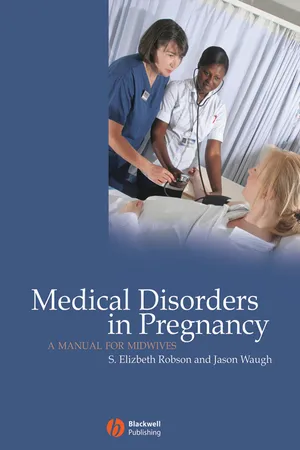
Medical Disorders in Pregnancy
A Manual for Midwives
- English
- ePUB (mobile friendly)
- Available on iOS & Android
Medical Disorders in Pregnancy
A Manual for Midwives
About This Book
The need for joint medical and midwifery care is stressed in the latest CEMACH report, with a recommendation that contemporary midwifery education prepares midwives for problems in pregnancy and adverse pregnancy outcome. Pre-conception care for women with medical disorders has also been stressed.
Medical Disorders in Pregnancy is one of the first texts written specifically for midwives that provides an outline of common medical disorders that may be affected by pregnancy or which may cause pregnancy complications. For ease of use, all conditions are presented on two page templates, and each addresses: An explanation of the condition; Standard 'Non-pregnancy' treatment; Pre-conception care; Antenatal care; Intrapartum care, and Postnatal care. The management, treatment and care by both doctors and midwives are provided to allow a mutual understanding of each others roles and responsibilities.
Frequently asked questions
Information
1
MIDWIFERY CARE AND MEDICAL DISORDERS
1 Midwifery Care and Medical Disorders
INTRODUCTION
PRE-CONCEPTION CARE
- Medical, surgical, psychological or infectious conditions that could complicate a future pregnancy, including any current medications or treatment
- Family history of disease and handicap, including genetic history
- Vaccination status
- Substance use, e.g. alcohol, cigarettes and street drugs
- Past obstetric and gynaecological history
- Present employment – to identify occupational hazards
- Current diet and nutritional history
- Lifestyle, including diet and exercise
- Weight and height measurement for calculation of the Body Mass Index (BMI) (see Appendix 13)
- Baseline pulse, blood pressure, urinalysis measurement
- Pelvic examination to include a cervical smear and screening for infection such as Chlamydia
- Respiratory and cardiac function
- Other function screening – if history indicates
- Karotyping – if indicated by family history
- Blood samples for full blood count (FBC), VDRL and rubella
- If indicated, additional screening for TB, hepatitis B, HIV, chickenpox, cytomegalovirus and toxoplasma
- Haemoglobinopathy screening for women originating from: Africa, West Indies, Indian subcontinent, Asia, Eastern Mediterranean countries and the Middle East. If affected, partner screening should be offered with genetic counselling6
- Folic acid: advise 0.4 mg daily1
- Vaccination, such as rubella or BCG for TB, dependent upon aforementioned antibody titres
- Contraceptive cover while investigations and treatment are initiated
- Act upon any anomalies detected in the baseline observations and order additional tests such as glucose tolerance test (GTT) and initiate treatment
- Refer the woman back to any specialist clinic and physician who has previously treated her; immigrant women may need referral for the first time.
- Review current drug therapy to identify those on drugs associated with teratogenic effects or contraindicated in pregnancy, and initiate change
- Increase the folic acid dosage for a history of neural tube defects, haemoglobinopathies, rheumatoid arthritis, coeliac disease, diabetes or epilepsy
- Prescribe suitable contraceptive cover whilst the above is addressed
- Initiate counselling about prognosis for both mother and prospective child
- Keeping a menstrual diary
- Pregnancy testing and need for early booking
- Perinatal diagnosis – practical aspects
- Smoking and alcohol cessation
- Street drug avoidance and cessation
- Over-the-counter medicines and therapies
- Domestic violence
- Stress avoidance
- Sport, exercise and general fitness
- Occupational hazards
- Animal contact and infection risk
- Food hygiene and hand washing
- Weight adjustment
- Health education initiatives and leaflets
- Patient organisations, e.g. Foresight, with additional options such as hair analysis for mineral deficiencies7
ANTENATAL CARE
Booking
- Person...
Table of contents
- Cover
- Contents
- Title page
- Copyright
- Contributors
- Foreword
- Preface
- Acknowledgements
- Acronyms and Abbreviations
- 1 Midwifery Care and Medical Disorders
- 2 Skin Disorders
- 3 Hypertensive Disorders
- 4 Heart Disease
- 5 Respiratory Disorders
- 6 Renal Disorders
- 7 Endocrine Disorders
- 8 Neurological Disorders
- 9 Musculoskeletal Disorders
- 10 Gastrointestinal Disorders
- 11 Autoimmune Disorders
- 12 Infectious Conditions
- 13 Metabolic Disorders
- 14 Haematological Disorders
- 15 Thrombo-embolic Disorders
- 16 Addictive Disorders
- 17 Psychiatric Disorders
- 18 Neoplasia
- Appendices
- Chapter References
- Index